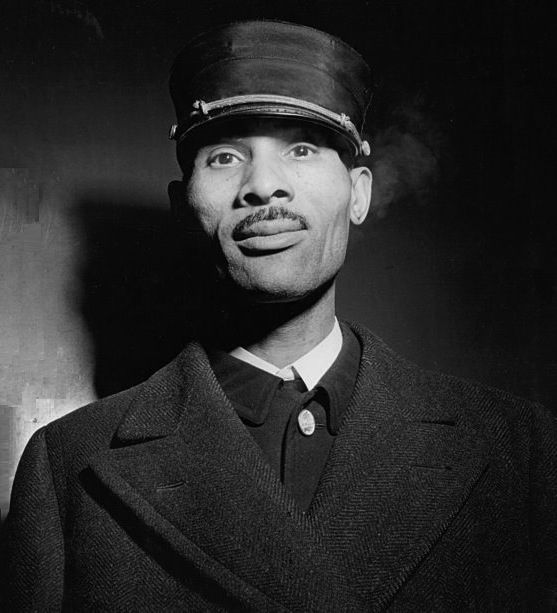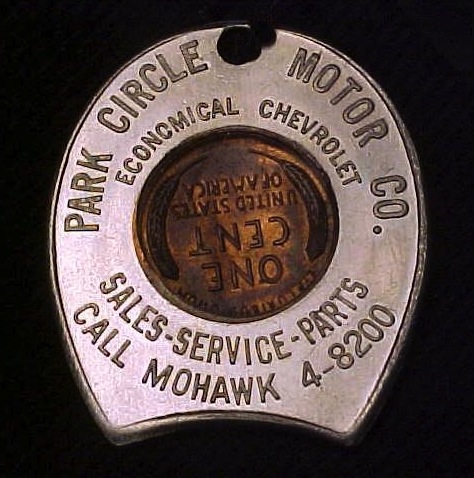
The author’s vision of what Deuteronomy Graves, a worker at the Vulcan Tire Co. in 1930s Baltimore, would look like, were he not a fictional character.
A Voice of Baltimore Feature, an excerpt from
ROOBY TAWR, a novel in progress
set in mid-20th Century Charm City
By Joel Foreman
When Deuteronomy Graves told Reuben Michael he would mitigate, he didn’t say noth’n ’bout the vortex.
Ruby wouldn’t have paid it no mind — D had all kinds of wild imaginings. Harmless stuff that Ruby listened to semi-seriously with one cocked eyebrow.
So there wasn’t any point in D sharing the bad feeling he got about the doctor Ruby was going to see up the Circle.
D had been up to Park Circle himself. Once! To mount a rush order of retreads on a used Chevy waiting for its new owner to drive off the lot at Park Circle Motor Company.
When D finished the task, he figured it’d be OK to spend a few minutes taking in the suburban neighborhood.
He’d read about it in the Jewish Times — read for-sale notices for the porched two-story row houses that lined the streets of Cottage, Towanda, and Park Heights Avenues.
Read ads for the strip on the 3500 block where you could get challah and sticky buns from Holtzman’s Bakery; corned beef, whitefish, and kishke from the Lapidus Delicatessen; and yahrzeit candles from Bertha Friedman’s dry goods store, to commemorate the Jewish dearly departed.
D had always thought of Park Heights as being way way out, a neighborhood he was never likely to visit. Yet here he was, taking it all in from the cab of the Vulcan Tire pickup truck.
He drove slowly around the Circle so as to contemplate the exotic entranceway to Carlin’s Amusement Park, with its twin towers, pagoda windows, ornate architectural details, and the façade of the skating rink, Iceland, looming above.
He drove past the green edge of Drew’d Hill (Druid Hill) Park, past the corner where the No. 5 and No. 33 streetcars stopped before splitting off to glide up the major arteries of Park Heights Avenue and Reisterstown Road, and decided to head north a few blocks.
He wanted to see the new synagogue — Shaarei Zion — that his and Ruby’s fellow Jews had built. It looked like a Greek temple with its triangular pediment and three columns in front.

Park Circle Motor Co. was a major Chevrolet dealership during the mid-20th Century at Park Circle, adjacent to Druid Hill Park.
A GOOD PLACE TO DAVEN
A good place to daven, he thought, imagining himself inside, swaying slightly back and forth with a tallit gadol — a large prayer shawl — over his shoulders and uttering the holy words of the Amidah, the central prayer of the Jewish liturgy (also called the Shmoneh Esreh).
So D had this real good feeling about Park Heights and its Circle.
Until he got the bad feeling, that is.
It came on him shortly before closing time on the day before Ruby’s doctor appointment. D was cutting the rubber teats off the day’s last batch of still-warm retreads and was having trouble staying focused on the task.
Created by vent holes in the steel doughnut that embraces a tire while its new tread is being baked into place, teats are thin half-inch rubber stubs rising out of the tread.
They’re a harmless byproduct, but customers don’t like the look of them. So D removes the teats with a tool that looks like a knife with a sharpened V at the end of the blade.
When he’s focused, he’s a machine, fluidly guiding each protuberance inside the cutting edges of the V and lopping it off so perfectly you’d never know it had been there in the first place.
But if he’s distracted, he might cut some of the teats in half, miss some altogether, and even cut away a small piece of good tread.
On the day in question, he’s distracted. Distracted by what he calls — with some reluctance, because he knows the word is pretentious — a “vision.”
It’s like when you’re driving on the highway and so focused on what’s going on inside your head, that you don’t see your exit whiz right by.
WHAT DEUTERONOMY SEES INSIDE HIS HEAD
What D sees inside his head, even as he continues mechanically to cut the teats, is a bird’s-eye view of Park Circle, round as a tire. No problem with that, until the whole Circle appears to break loose from its moorings in the earth and begins to spin like a roulette wheel.
As it picks up speed, a whirlwind of pulsating energy snatches up the streets, the cars, the electric streetcar lines, the streetlights; the Carlin’s Park entranceway, the row houses lining Park Heights Avenue… and the synagogue.
It’s a vortex sucking unlucky stuff into its gaping maw.
Focused inward on that raw and seething vision, D suddenly realizes that the tread he’s been trimming looks like a black field of hacked and devastated stumps.
Sheeeit! he whispers in exclamation to himself, and then, Kina Hora! the Yiddish exhortation, accompanied by two spits, that’s supposed to keep “The Evil Eye” away.

Through most of the 20th Century, American cigarette companies advertised — in magazines, newspapers, and on radio and television — that their specific brands were preferred by doctors, most of whom also smoked. “Dr. Tompakov” switched from Luckies to Pall Malls because he believed the American Tobacco Company, which owned Lucky Strike until 1976, was lying to consumers.
DR. TOMPAKOV’S OFFICE
Sitting at his desk the morning of Reuben Michael’s visit, Dr. Eugene Tompakov scans the pages of Time magazine — the Ethiopian “King of Kings,” Emperor Haile Selassie, is on the cover again — and ponders what he will say when young Michael arrives for his 7:30 a.m. appointment.
Tompakov could have delivered the news on the phone, but it was serious enough, potentially, who could say, to warrant a face-to-face. Reuben Michael’s x-rays showed some worrisome bone-cell hyperactivity.
Tompakov stops flipping through the magazine when an ad for Lucky Strike, a brand he used to smoke, catches his attention.
Lying bastards, he says to himself, when he reads that “20,679 physicians say ‘Luckies are less irritating.’”
But sometimes lying’s not so bad, he thinks. It wouldn’t be entirely bad if I lied a little bit today about what Ruby might be facing in the future.
“Might” is the operative word, he concludes. Michael might have an entirely uncomplicated future and die peacefully at the ripe old age of 75.
But the bone-cell hyperactivity was troubling.
The rheumatologist who examined Michael’s x-rays assured Tompakov that the hyperactivity — known as osteitis deformans, or “Paget‘s disease ” — rarely developed beyond the minor discomfort that Ruby originally reported.
That was encouraging, though Tompakov’s follow-up research was less so.
At its worst, Paget’s could produce arthritis, kidney stones, bone tumors, loose teeth, hearing loss, even cardiovascular dysfunction.
And “damaged frames.”
When Ruby arrived, Tompakov lingered on the quaint phrase he’d read in a 19th Century article about Sir James Paget, the British surgeon and pathologist who first diagnosed the disease.
With Ruby sitting in one of the bulky leather club chairs arrayed in front of Tompakov’s desk, the doctor treated himself to a Pall Mall and slowly divulged as little alarming information as was professionally responsible.
He avoided abstractions like fibrosity and hypervascularity. Tried to compare the natural process of bone remodeling to what the Baltimore road-renewal crews had been doing for decades — pulling up old cobblestone and replacing it with asphalt.
“Some cells absorb worn-out bone,” he explained to Reuben Michael. “Others replace it. This goes on all the time.”
TO SIGNAL NO CAUSE FOR ALARM
This is what Tompakov said as he folded his hands on his stomach and — wanting to signal that there was no cause for alarm — relaxed into the high back of his swivel chair.
“Sometimes the cells work overtime. Yours have been doing so. And that’s when we might get problems.”
If the hyperactive cells in Ruby’s legs continued to work overtime and the new bone was defective, there would be time at a later date to explain in greater detail what Ruby faced down the line.
For now, when Ruby asked if Paget’s was anything to really worry about, the doctor said it probably would not amount to much.
“Yes, the worst cases could involve some ‘bone trouble’” — he avoided the less pleasant term, “deformation“ — “and some other symptoms,” he explained.
“But all of this is highly unlikely,” the doctor counseled, and concluded the meeting with a promise to monitor the young man’s condition.
Ruby was gifted at this time with a positive approach to life. He was the “Yes Man!”
It just came naturally and was supported by his reading of books like Emmet Fox’s Power through Constructive Thinking.
Given this habit of mind and Tompakov’s assurances, Ruby decided the “inconvenience” (the term he substituted for “disease”) was a minor blip in what he expected to be a long and deeply satisfying life.
That long-legged Lady Fortune had kissed him on the mouth. She and Ruby were strolling arm in arm down Holiday Lane, and that’s just the way it was going to be.
As Ruby moved from the stuffy warmth of the Tompakov house and office and into the bracing chill of the early April morning, the “bone trouble” drifted from his mind like a single errant cloud blown westward on an otherwise sunny day.
Watching from the bay window in his office, Tompakov admired the easy grace with which Ruby descended, two steps at a time, the long concrete stairs set in the hill leading down to the street.
He tried to remember, but could not, the name of that biblical figure whose faith god tested with a plague of hurts.
joelforeman@voiceofbaltimore.org
CHECK OUT EXCERPT 1 OF ROOBY TAWR (ROGERS ROOBY — Waiting for a streetcar in 1930s Baltimore) by clicking here
EDITOR’S NOTE:
The working title of Joel Foreman’s book, Rooby Tawr, refers to the character Deuteronomy Graves’ Baltimorese pronunciation of the word “tire.” One of Graves’ jobs at the fictional Vulcan Tire Co. was to trim the teats off the newly vulcanized and retread auto and truck tires.

Tawr Teats on a new or retread tire: Note the twin protuberances at top & bottom of photo, before being metic- ulously trimmed off by D Graves.
The term “teats” (pronounced tits) is often used to refer to part of the protuberances of a cow — udders — as well as those on tires. Ex-President Jimmy Carter, for example, a former (peanut) farmer, famously used the word in a TV interview years ago on the NBC “Tonight Show.”
All characters depicted in this work are fictitious. Any resemblance to real persons, living or dead, is purely coincidental. However photos depicting fictitious characters — such as Deuteronomy Graves in the current excerpt — are grounded in reality.
Joel Foreman was born in Baltimore, attended Baltimore City College and graduated from Milford Mill High School in 1960. A member of the English Department at George Mason University for more than 35 years, he is now Professor Emeritus, having published some 30 articles on Hollywood cinema, the Internet and education, video games and computer generated graphics, along with other works.
The novel in progress Rooby Tawr is Foreman’s initial foray into fiction. (For his complete thumbnail biography, click “Staff” under the Main Menu at left.)







December 4th, 2014 - 9:24 AM
Joel, I like the way this story is taking form. I remember those carefree days and how we thought that nothing could ever slow us down. Then came the Vietman war which our politicians labelled a “military action.” The slow pace of your novel reflects the good times where shearing off teats was just part of the job. The description of the medical office was right on and I remember the awe we felt when we visited the doctor. They were truly Gods in our eyes. Now, move your story along but have twists and turns along the way. Waiting for more; keep up the good work and Mazeltoff!
December 6th, 2014 - 10:57 AM
“so as to” wordy and a bit pedantic; just say “he drove around the Circle so he could contemplate (observe) (is this really something he contemplates or simply observes?)
“it’s a vortex sucking unlucky stuff into a gaping maw.” (not sure this is the image you want, seems a bit heady; not sure what this adds to the narrative)
I like the build-up to Ruby’s appt. with the doctor and how both men handle the information, the doctor downplaying the diagnosis and Ruby’s optimism in beating back any concerns he might have.
I like the local color of the streets and name places, which my parents would mention from time to time in remembering their time in Baltimore
December 6th, 2014 - 12:32 PM
Mr. Foreman:
I enjoy reading your sparse, fast-paced narrative. Your style reminds me a bit of Mohsin Hamid’s fiction, though your tone is much softer. Look forward to the next installment.
June 7th, 2015 - 3:31 AM
[…] and ‘ANY BONDS TODAY?’ — Bugs Bunny and the Good Jew) by clicking here AND here AND here. EDITOR’S […]
November 23rd, 2016 - 7:27 PM
[…] ARMISTICE DAY — Baltimore’s German heritage and the Great War) by clicking here, here, here, AND here. EDITOR’S […]
November 25th, 2016 - 8:04 PM
[…] and BUDDY YOUNG SPECIALS — Adlai Stevenson and hard-shell crabs) by clicking here, here, here, here, and here. EDITOR’S […]